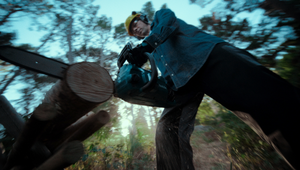
Rants Revisited: Treatment Wars

The 2013 Original
(Originally published on The Beak Street Bugle)
Are treatments getting out of hand? Is it all just smoke and mirrors hand in hand with conspicuous consumption?
Surely a job could be rewarded based on a director’s skill, charisma and vision rather than some nice type and a good picture researcher?
Perhaps it is the agency and client’s ever-increasing petulance that demands these huge and colourful tomes, or maybe it’s just production companies finding more ways to out-do each other and kill more trees.
I am not so old that I remember when clients just gave you some cash, said “make a movie” and you went away somewhere gorgeous with your director of choice and then came back with a nice film. But I do remember Life Before Treatments.
This is how it went: As a PA you set up a meeting with a couple of directors. You had a chat. You set up a Recommendation of Director meeting with the client. If required, you did a three-quote comparison. As a producer you and the creatives shared your favourite reel. You said what was and what wasn’t included. The client faffed. You maybe got some start-up money. You nagged for the full sign off. You threatened there would be no PPM if the first 50% wasn’t paid.
Not so different really, except the director bit.
Back in the day you talked through what the director had to say, you gushed a bit, perhaps showed a couple of examples, resorted to explaining who the cameraman was if they weren’t buying it, said you would find some more relevant commercials if they wanted to see them. Again, same old. But you didn’t turn up with a forest worth of paper and plastic with some gorgeous and thoroughly-researched mounted photos and a paragraph that started:
“Casting is really important.”
The first glimpse I remember of the treatment was when I was told off by a HTV for not taking notes in the director meetings. These notes were crucial if we were going to distinguish which director said what. Suitably chastened I stopped relying on memory, instinct and chemistry alone.
Then directors started sending in summaries of what they said and they wanted to do. Note taking was now redundant. Which was nice.
Next, account people started demanding to see treatments: “Client must see them as soon as they can.” Blind panic and raised blood pressure if, God forbid, you wanted to recommend someone who really didn’t do treatments.
What kind of director were we talking to? Who did they think they were?
And along came Treatment Wars.
Who would use the heaviest paper? Will the heft be thicker than the walls in most people’s houses? Bound or not bound? Who will have the best tearsheets of models we could never afford as examples of the kind of natural beauty we were looking for?
What if they didn’t say “thank you for the opportunity,” “I really love this script”? Did they hate us or were they just restrained? He did say “it’s going to be awesome,” which is great because that’s just what we want. Any gimmicks?
A video treatment – cool. But the client doesn’t like guys with beards, could he shave and re-film it? The first big fat parcel arrives in TV. Six plastic-coated books of wisdom. Producer waves it at creatives who promise to look at it later. But then the bundles of joy from their new favourite production company arrive (great meeting, nice of them to take us to lunch). All is marvellous. But that shot of the Eiffel Tower is a bit phallic and misleading according to the account director. Can they just change the reference to St Paul’s before it goes up to the client?
Production company is informed of the change and re-sends some more laminated loveliness. The other director’s treatment is now begrudgingly dissected:
It’s actually brilliant! Oh God, now who are we going to recommend?
Could we just change the wording on casting to say ‘quite attractive’ rather than ‘stunning’ for the leading lady and re-submit?
Runners are re-copying now. Not all of them will be fully bound is that okay? On their way any minute.
Bike comes late; everyone is already on the train to Preston. Can we email the revised one to client please? File too big. Never mind – we will present the original then and talk through the girl next-door qualities of the star.
Marketing manager really liked it – that Kate Moss photo was hot, but he hates the scene with the pigeon. Can we have it re-sent before he presents to his boss? Oh, sorry, forgot to say lose the reference to Spinal Tap. Creative sulks, the whole thing lives and dies on the flying rat. Director sulks, he loves a mockumentary.
Negotiations are done, version six of the treatment goes to senior client.
It is approved subject to making sure there is a version that actually spells the name of the product correctly. Actually, such straightforward go-ahead is rare but this article will never end if we touch on all the possible scenarios, perhaps another piece of approval process soon.
And piled on desks in every department of the agency are 37 big, fat, colourful ex-treatments that are less than useless. Time to recycle. Only you can’t put plastic in with the paper, and you have to tear the binding and it’s really late now and there are drinks downstairs so sod it just put it in the bin.
The following Tuesday the whole agency gets a hectoring all staffer about what you can and can’t throw away.
Is advertising’s carbon footprint not shameful enough?
Is there a solution? The only one I can think of is to build in a draft treatment stage, where the director comes and shares his upcoming vision with all the key players at the agency, who then share it with the key clients, who sell it up the line. Once all feedback is in then we can set about cutting and pasting and
packaging and then sharing with the key players at the agency, who then share it with key clients, who sell it up the line. Then do this all again with the storyboard…
Or we could just miss out on the juicy, shiny stage and sell an idea and then make an ad. It should certainly save on pre-production costs, but then how would the interns/treatment writers/picture researchers/runners/YouTube watchers fill their time. And what would we put in our lovely canvas totes and stolen art bags?
We could all agree that on this one we will just talk it through, but the truth is, like the pitch early in Mad Men when they were specifically told not to shoot a test commercial, someone will cheat and find an opportunity to impress with a pertinent clip and an example of style. And so it begins again.

Post Script 2023
This, at first glance, was all about wasted paper and effort An early cry for sustainability.
I would like to think that I single-handedly changed habits, it was me who made people think again about endless printing, who reminded creatives that it’s the content that was impressive, not the heft of the paper.
A decade later and we have certainly progressed. We are now fully virtual.
Going online has spawned new opportunities to show off and showcase – links, animations, logo love-ins – and as weight and deforestation no longer come into it, a platform with no limits.
But Treatment Wars was not just about the stationary. It was also asking how much bells and whistles are really needed to get the director’s vision across.
It is worth reposting now as it looks like we are spinning out of control again.
The perceived expectation of a treatment is limitless.
Now we can really go for it, we now demand teams of researchers, writers, designers and deck divas to put any treatment together.
No one dares submit anything less than a potential Lion-winning deck (actually could that be a new category at Cannes?) and we spiral.
Phrases like "really we only need a one pager" are ignored, even if, as is the norm, the delivery deadline is super fast track and unreasonable.
Production companies rightly resent the cost, and point out that it is unfair to go to all this trouble with no guarantee of a reward.
But is this self-abuse?
Do agencies and clients really demand to enter this epic virtual world? Does everyone really read a Treatment end to end. Do they actually click on all the lovingly researched YouTube clips?
Is a treatment a vanity project?
Should we be reverting back to a neatly constructed summary of approach from the director and a couple of references? Could we stick to 10 pages?
And the answer, as concluded in the original piece, is yes we probably could. As long as no one cheats.















